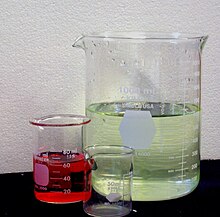Beaker
A beaker is a simple glass device for various purposes in (mostly scientific) laboratories. This is understood to be a cylindrical beaker with a flanged rim at the top and usually a spout. A rough volume scale is usually printed on the side.
Along with the test tube and the Erlenmeyer flask, the beaker is one of the most frequently used glass vessels in the laboratory .
The beaker is used for a wide variety of tasks that require a simple glass vessel, such as collecting or mixing liquids or preparing simple solutions. It is inexpensive, is easy to fill thanks to the large opening and allows the contents to be stirred with a glass rod, for example. The transparent borosilicate glass usually used as a material is resistant to heat and most chemicals, so that beakers made from it are also suitable as simple reaction vessels and for heating. Polypropylene beakers are not heat-resistant and also less resistant to chemicals.
In the case of a conventional beaker ("wide / wide shape"), the ratio of height to diameter is usually around 1.4. This normal version with a spout is sometimes referred to as "Griffin form" (especially in the Anglophone world). In the case of beakers in the "tall form", the height usually corresponds to about twice the diameter. This shape is sometimes referred to as a "Berzelius beaker".
A beaker differs from a flask in that it has a straight side wall. The exception is the slightly conical Philips cup .
Beakers are available in sizes from 1 ml up to twenty liters.
The DIN EN ISO 3819: 2013-12 specifies the following sizes and designs
| design type | Nominal volume ml |
Outer diameter mm +/- 5% |
Total height mm max. |
Wall thickness mm min. |
|---|---|---|---|---|
| Low mug | 5 | 22nd | 32 | 0.7 |
| 10 | 26th | 37 | 0.7 | |
| 25th | 34 | 52 | 0.7 | |
| 50 | 42 | 62 | 0.8 | |
| 100 | 50 | 72 | 0.9 | |
| 150 | 60 | 82 | 1.0 | |
| 250 | 70 | 97 | 1.1 | |
| 400 | 80 | 113 | 1.2 | |
| 500 | 85 | 118 | 1.3 | |
| 600 | 90 | 128 | 1.3 | |
| 800 | 100 | 138 | 1.3 | |
| 1000 | 105 | 148 | 1.3 | |
| 2000 | 130 | 188 | 1.4 | |
| 3000 | 150 | 214 | 1.7 | |
| 5000 | 170 | 274 | 2.0 | |
| 10,000 | 220 | 360 | 2.0 | |
| tall cups | 50 | 38 | 72 | 0.8 |
| 100 | 48 | 82 | 0.9 | |
| 150 | 54 | 97 | 1.0 | |
| 250 | 60 | 123 | 1.1 | |
| 400 | 70 | 133 | 1.2 | |
| 500 | 79 | 140 | 1.3 | |
| 600 | 80 | 153 | 1.3 | |
| 800 | 90 | 178 | 1.3 | |
| 1000 | 95 | 183 | 1.3 | |
| 2000 | 120 | 244 | 1.4 | |
| 3000 | 135 | 284 | 1.7 | |
| 5000 | 160 | 324 | 2.0 | |
| Thick-walled design | 150 | 60 | 82 | 1.1 |
| 250 | 70 | 97 | 1.2 | |
| 400 | 80 | 111 | 1.4 | |
| 600 | 90 | 127 | 1.4 | |
| 1000 | 105 | 147 | 1.4 | |
| 2000 | 132 | 187 | 1.5 | |
| 5000 | 170 | 275 | 2.5 |
Web links
Individual evidence
- ↑ a b British Standard 6523 (1984) Glass beakers for laboratory use .
- ^ AI Vogel (1974) Practical Organic Chemistry Third edition (Longman, London) page 46 ISBN 0-582-44245-1 .
- ↑ Draft standard for beakers made of borosilicate glass 3.3.Retrieved on February 15, 2016.


